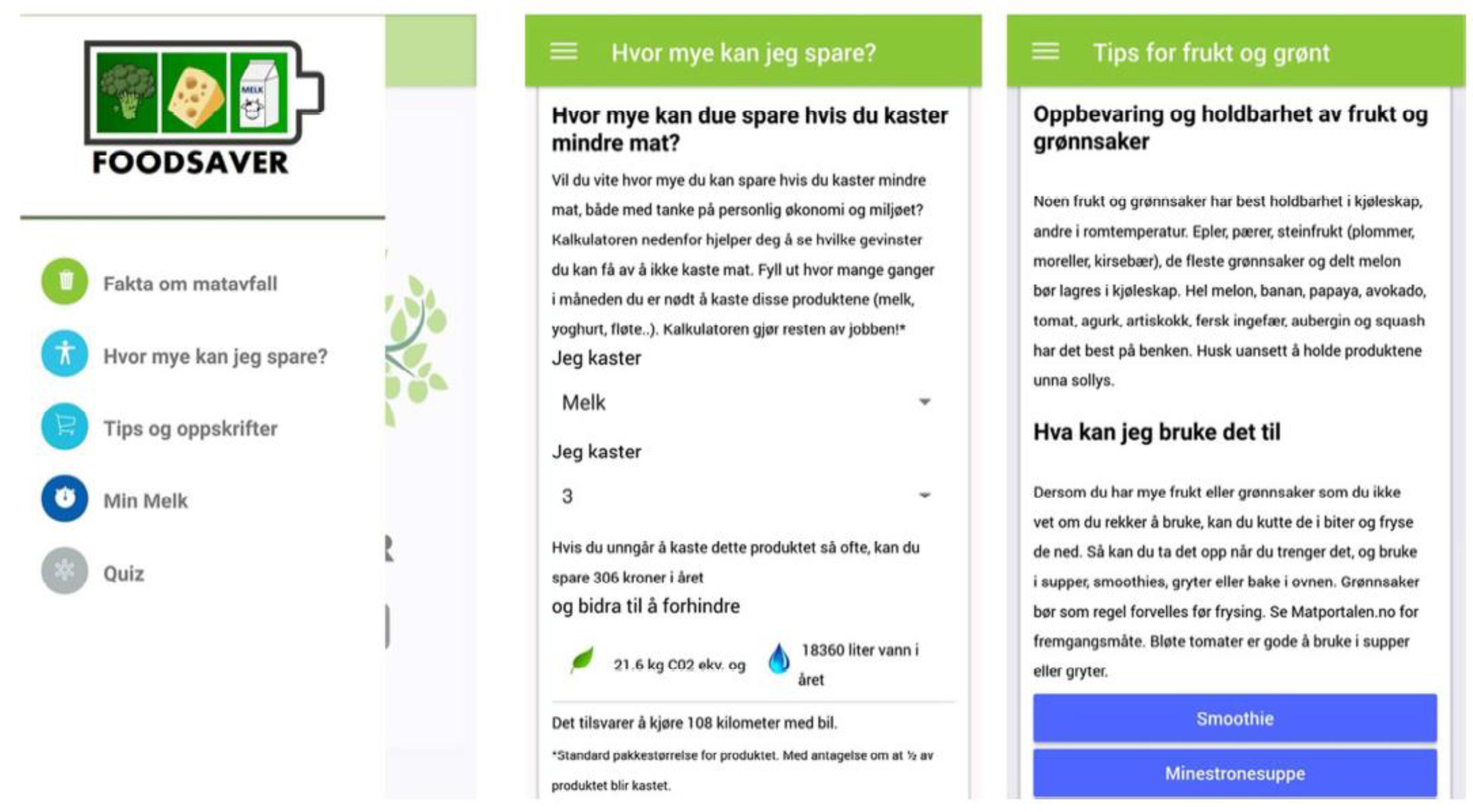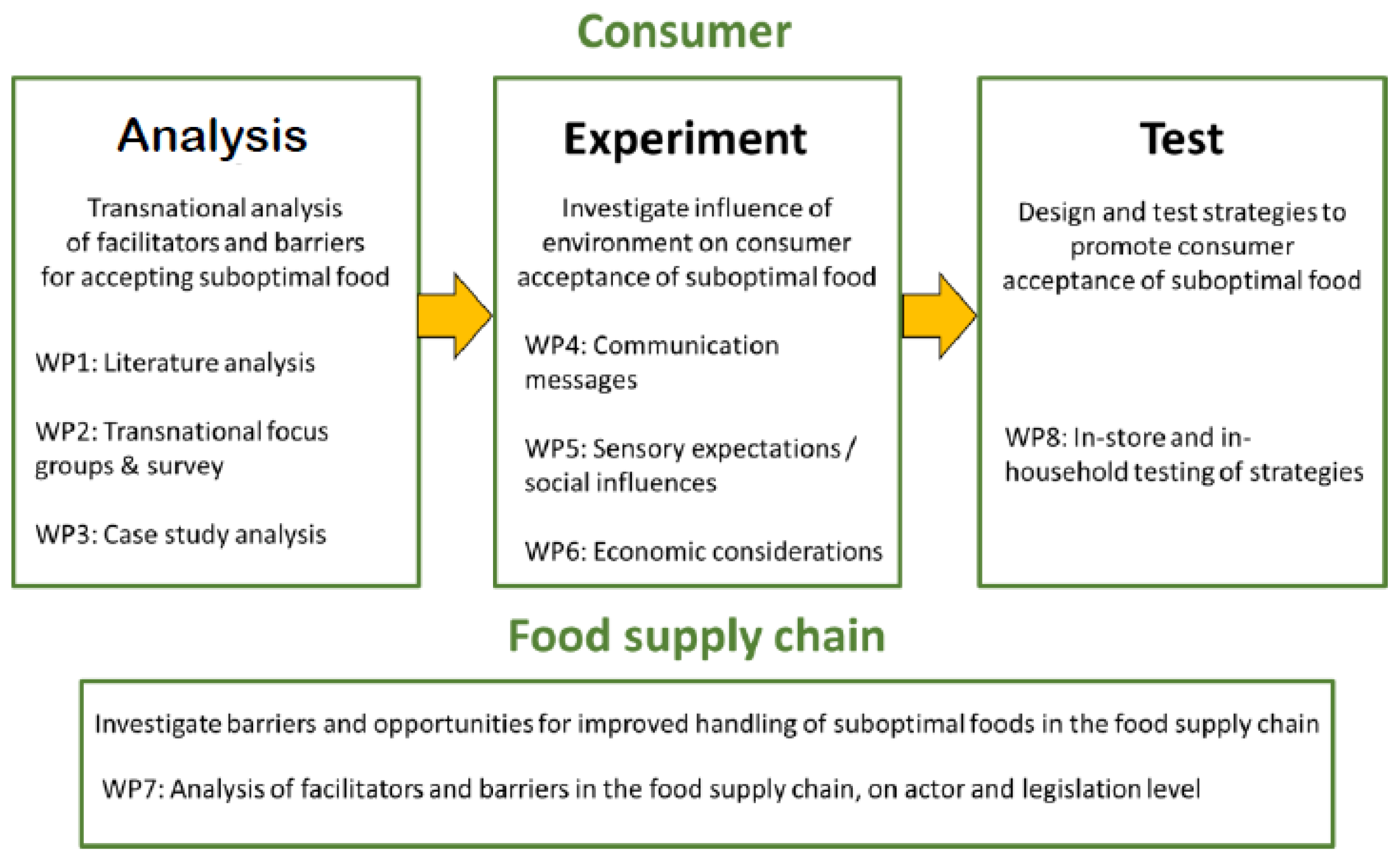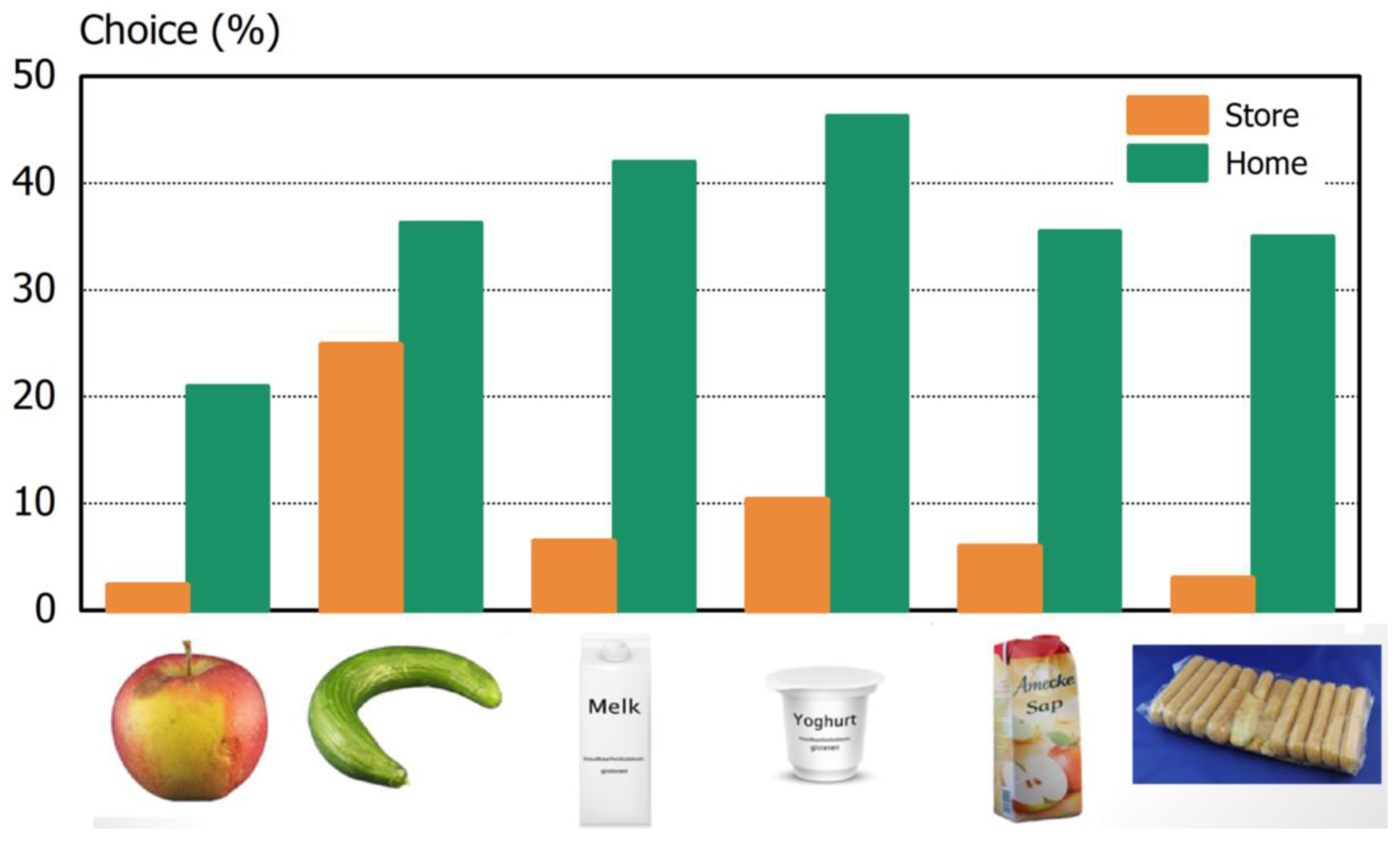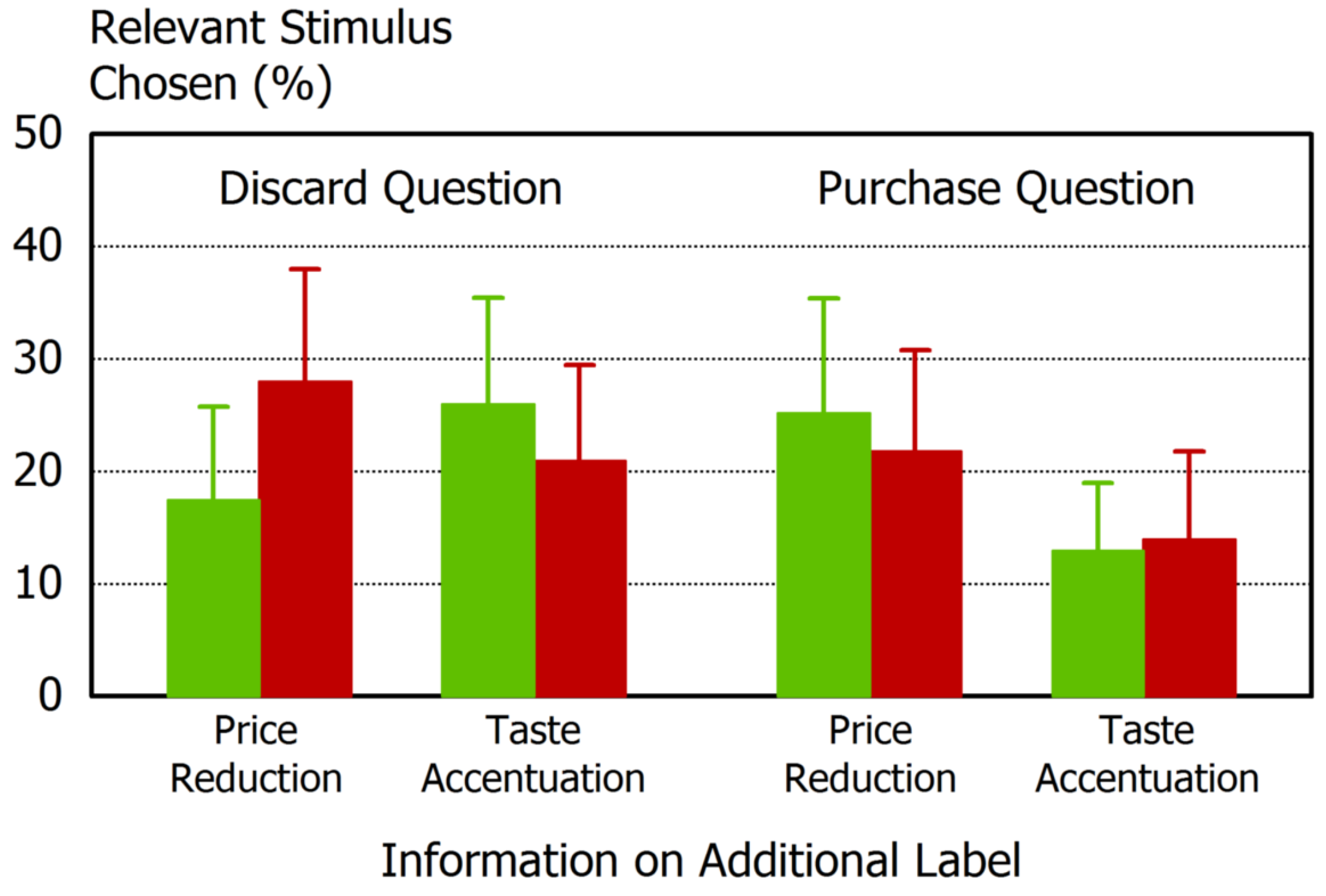Consumers in a Sustainable Food Supply Chain (COSUS): Understanding Consumer Behavior to Encourage Food Waste Reduction
Abstract
:1. Introduction
- Understanding the barriers and facilitators for acceptance of visually suboptimal foods both before and after purchase through the consumer;
- Designing and testing strategies to promote the consumption of visually suboptimal foods; and
- Investigating how winning strategies can be successfully implemented in the food chain.
2. Suboptimal Foods and Food Waste
2.1. Product-Related Factors
2.1.1. Product-Related Factors: Experimental Approach
2.1.2. Product-Related Factors: Major Findings
2.2. Person-Related Factors
2.2.1. Person-Related Factors: Experimental Approach
2.2.2. Person-Related Factors: Major Findings
3. Communicating Food Waste Reduction to the Consumer
3.1. Product Cues Attracting Attention on Suboptimal Foods
3.1.1. Attracting Attention: Experimental Approach
3.1.2. Attracting Attention: Major Findings
3.2. Expectation and Perception of Suboptimal Foods
3.2.1. Expectation and Perception: Experimental Approach
3.2.2. Expectation and Perception: Major Findings
3.3. Messages and Channels to Communicate Suboptimal Foods
3.3.1. Communication Channels: Experimental Approach
3.3.2. Communication Channels: Major Findings
3.4. Price-Reduction to Sell Suboptimal Food
4. Ways of Reducing Food Waste along the Food Supply Chain
4.1. Business Potential and Barriers of Suboptimal Foods
4.2. Take-Back Clause and Its Influence on Food Waste, Prices, and Retail Market Power
- In general, not all of the unsold bread is returned to the supplier; a fraction is treated by the store itself through different channels or just ends up in the garbage of the store.
- The supplier collects the unsold bread two to three days before the best-before date. The returned quantity differs between retail stores and between suppliers.
- The bread inventory usually is consumed LIFO (last-in-first-out). Consumers demand freshness as prime factor when buying bread—hence they will always buy the fresher and leave behind the rest. When the suppliers need to add fresh bread, they eventually withdraw old bread 1–2 days before the best-before date. This is the trade-off for the maintenance of a certain amount of inventory at all times.
- Bakeries consider that, to a great extent, the take-back clause is a result of the market power of the retailer. Sweden has one of the highest concentrations of retailers in Europe [57]. Retail outlets request full shelves at all time, regardless of actual demand. By paying only for what is sold, retailers push the cost of returns to the supplier. Although bakeries understand that there should always be a certain amount of bread on the shelves, they do not agree that they should bear the entire cost of unsold bread. Furthermore, it is believed that this process increases food waste because bakeries argue that they are forced to produce—and waste—more bread than they would if they had full control of how much bread should be delivered, or if retailers paid for all—both sold and unsold—bread.
- Retailers and bakeries agree that a certain amount of waste is unavoidable. The amount of bread placed on shelves is based on forecast, not so much on actual need. Hence it is only natural to have some bread left over as waste.
- Weather appears to be also a factor of waste, as it affects shopping behavior; unexpected weather changes may increase or decrease purchase and, therefore, influence the amount of how much is wasted.
- The production method of bread is of importance. Bakeries which bake and freeze and then distribute frozen bread have a lower percentage of bread returns (approx. 4–5%) than those which deliver freshly baked bread (approx. 12–14%). This is because the store management is able to maintain the shelf inventory by simply taking bread out of the freezer (sometimes more than once during the day) for letting it unthaw on the shelves, hence, being always “fresh”.
- The distribution route of the delivery vehicle of the bakery and the size of the store are also important. The last store in the route usually receives what is remaining in the lorry regardless of its actual needs, and hence often receives more than necessary. This is because the bakery agents do not want to return fresh bread to the bakery; they tend to “dump” all leftovers to the last store. Because, usually, distribution routes start with the large and end with smaller stores, it is the smaller stores that exhibit more waste in relative terms.
- The governance of the distribution chain may affect the amount of bread waste. Some bakeries internalize the process using their own delivery trucks, while others outsource it to logistics companies. We suspect that there may be a difference between the two schemes; however, it is still unclear which structure produces more waste.
5. Conclusions
- Choice experiments and focus groups revealed that consumers have a low tendency to purchase and consume suboptimal foods, and it is quite difficult to motivate them for doing so.
- The type of suboptimality plays a distinct role in the choice process of the consumer (as deduced from the choice experiment) and significantly impacts the influencing techniques that are necessary to motivate consumers to buy and consume suboptimal foods.
- Not only consumers are relatively pessimistic about changes of success of suboptimal food products, also supply chain actors do not perceive high chances of success for suboptimal foods. There is a mismatch between consumer needs (e.g., large discounts) to buy and consume such products, and the needs of the supply chain actor (e.g., no lower prices due to transporting problems of suboptimal products) for the selling of suboptimal foods.
- Price reduction of suboptimal foods is a powerful tool to reduce food waste at the retailer level. It should not be expected to increase food waste at home, if a high quality is assured and consumers are provided tips on usage of the items.
- Supply chain food waste reduction initiatives need good and broad collaboration as a basis, entrepreneurial spirit and drive in the organization, and a good ‘timing’ to achieve success.
- Consumers differ in their choice of suboptimal foods and food waste behavior depending on their food (waste)-related lifestyle, in particular regarding food involvement, price orientation, planning and using meals as social event, which is why policy and stakeholder actions should be targeted to different consumer segments to be more efficient.
- Intervention measures such as a mobile phone app are capable of delivering messages about food waste to consumers at home, and some consumers may benefit from using such an app to prevent wastage of suboptimal foods in the home.
Acknowledgments
Author Contributions
Conflicts of Interest
Appendix A


References
- Food and Agricultural Organization. Food Wastage Footprint: Impacts on Natural Resources; Summary Report of the Food and Agricultural Organization of the United Nations; FAO: Rome, Italy, 2013; ISBN 978-92-5-107752-8. [Google Scholar]
- Godfray, H.C.J.; Beddington, J.R.; Crute, I.R.; Haddad, L.; Lawrence, D.; Muir, J.F.; Pretty, J.; Robinson, S.; Thomas, S.M.; Toulmin, C. Food security: The challenge of feeding 9 billion people. Science 2010, 327, 812–818. [Google Scholar] [CrossRef] [PubMed]
- Parfitt, J.; Barthel, M.; Macnaughton, S. Food waste within food supply chains: Quantification and potential for change to 2050. Philos. Trans. R. Soc. B 2010, 365, 3065–3081. [Google Scholar] [CrossRef] [PubMed]
- Raak, N.; Symmank, C.; Zahn, S.; Aschemann-Witzel, J.; Rohm, H. Processing- and product-related causes for food waste and implications for the food supply chain. Waste Manag. 2017, 61, 461–472. [Google Scholar] [CrossRef] [PubMed]
- Aschemann-Witzel, J.; de Hooge, I.; Amani, P.; Bech-Larsen, T.; Oostindjer, M. Consumer-related food waste: Causes and potential for action. Sustainability 2015, 7, 6457–6477. [Google Scholar] [CrossRef] [Green Version]
- Quested, T.E.; Marsh, E.; Stunell, D.; Parry, A.D. Spaghetti soup: The complex world of food waste behaviours. Res. Conserv. Recycl. 2011, 79, 43–51. [Google Scholar] [CrossRef]
- Waste & Resources Action Programme. Household Food and Drink Waste in the UK; Final Report; WRAP: Banbury, UK, 2009; ISBN 1-84405-430-6. [Google Scholar]
- De Hooge, I.E.; Oostindjer, M.; Aschemannn-Witzel, J.; Normann, A.; Losse, S.M.; Almli, V.L. This apple is too ugly for me! Consumer preferences for suboptimal food products in the supermarket and at home. Food Qual. Prefer. 2017, 56, 80–92. [Google Scholar] [CrossRef]
- Scholderer, J.; Brunsø, K.; Bredahl, L.; Grunert, K.G. Cross-cultural validity of the food-related lifestyles instrument (FRL) within Western Europe. Appetite 2004, 42, 197–211. [Google Scholar] [CrossRef] [PubMed]
- Yue, C.; Alfnes, F.; Jensen, H.H. Discounting spotted apples: Investigating consumers’ willingness to accept cosmetic damage in an organic product. J. Agric. Appl. Econ. 2009, 41, 29–46. [Google Scholar] [CrossRef]
- Lagerkvist, C.J.; Hess, S. A meta-analysis of consumer willingness to pay for farm animal welfare. Eur. Rev. Agric. Econ. 2011, 38, 55–78. [Google Scholar] [CrossRef]
- Bunn, D.; Feenstra, G.W.; Lynch, L.; Sommer, R. Consumer acceptance of cosmetically imperfect produce. J. Consum. Aff. 1990, 24, 268–279. [Google Scholar] [CrossRef]
- Tsiros, M.; Heilman, C.M. The effect of expiration dates and perceived risk on purchasing behaviour in grocery store perishable categories. J. Mark. 2005, 69, 114–129. [Google Scholar] [CrossRef]
- Wansink, B.; Wright, A.O. “Best if used by…” how freshness dating influences food acceptance. J. Food Sci. 2006, 71, S354–S357. [Google Scholar] [CrossRef]
- Brunsø, K.; Scholderer, J.; Grunert, K.G. Testing relationships between values and food-related lifestyle: Results from two European countries. Appetite 2004, 43, 195–205. [Google Scholar] [CrossRef] [PubMed]
- Huang, G.; Grunert, G.; Lu, D.; Zhou, Y. Chinese urban consumers segmentation based on modified food-related lifestyle (FRL). J. Int. Consum. Mark. 2015, 27, 328–343. [Google Scholar] [CrossRef]
- Pérez-Cueto, F.J.; Verbeke, W.; de Barcellos, M.D.; Kehagia, O.; Chryssochoidis, G.; Scholderer, J.; Grunert, K.G. Food-related lifestyles and their association to obesity in five European countries. Appetite 2010, 54, 156–162. [Google Scholar] [CrossRef] [PubMed]
- Tabachnik, B.G.; Fidell, L.S. Using Multivariate Statistics, 5th ed.; Pearson Education Inc.: Boston, MA, USA, 2007. [Google Scholar]
- Punj, G.; Stewart, D.W. Cluster analysis in marketing research: Review and suggestions for application. J. Mark. Res. 1983, 20, 134–148. [Google Scholar] [CrossRef]
- Aschemann-Witzel, J.; Lengard Almli, V.; de Hooge, I.; Oostindjer, M. Fine-tuning the fight against food waste by aligning macromarketing and public policies with consumer lifestyles. J. Macromark. 2017, in press. [Google Scholar]
- Sunstein, C.R.; Reisch, L.A. Automatically green: Behavioral economics and environmental protection. Harv. Environ. Law Rev. 2014, 38, 127–158. [Google Scholar] [CrossRef]
- Aschemann-Witzel, J.; Jensen, J.H.; Jensen, M.H.; Kulikovskaja, V. Consumer behaviour towards price-reduced suboptimal foods in the supermarket and the relation to food waste in households. Appetite 2017, 116, 246–258. [Google Scholar] [CrossRef] [PubMed]
- Aschemann-Witzel, J.; de Hooge, I.E.; Rohm, H.; Normann, A.; Bossle, M.B.; Grønhøj, A.; Oostindjer, M. Key characteristics and success factors of supply chain initiatives tackling consumer-related food waste—A multiple case study. J. Clean. Prod. 2017, 155, 33–45. [Google Scholar] [CrossRef]
- Aschemann-Witzel, J.; de Hooge, I.E.; Normann, A. Consumer-related food waste: Role of food marketing and retailers and potential for action. J. Int. Food Agribus. Mark. 2016, 28, 271–285. [Google Scholar] [CrossRef]
- Stefan, V.; van Herpen, V.; Tudoran, A.A.; Lähteenmäki, L. Avoiding food waste by Romanian consumers. The importance of planning and shopping routines. Food Qual. Prefer. 2013, 28, 375–381. [Google Scholar] [CrossRef]
- Rousseau, S.; Vranken, L. Green market expansion by reducing information asymmetries: Evidence for labeled organic food products. Food Policy 2013, 40, 31–43. [Google Scholar] [CrossRef]
- Grunert, K.G. Current issues in the understanding of consumer food choice. Trends Food Sci. Technol. 2002, 13, 275–285. [Google Scholar] [CrossRef]
- Kosa, K.M.; Cates, S.C.; Karns, S.; Godwin, S.L.; Chambers, D. Consumer knowledge and use of open dates: Results of a web-based survey. J. Food Prot. 2007, 70, 1213–1219. [Google Scholar] [CrossRef] [PubMed]
- Helmert, J.; Symmank, C.; Pannasch, S.; Rohm, H. Have an eye on the buckled cucumber: An eye tracking study on visually suboptimal foods. Food Qual. Prefer. 2017, 60, 40–47. [Google Scholar] [CrossRef]
- Atalay, A.S.; Bodur, H.O.; Rasolofoarison, D. Shining in the center: Central gaze cascade effect on product choice. J. Consum. Res. 2012, 39, 848–866. [Google Scholar] [CrossRef]
- Tatler, B.W. The central fixation bias in scene viewing: Selecting an optimal viewing position independently of motor biases and image feature distributions. J. Vis. 2007, 7, 1–17. [Google Scholar] [CrossRef] [PubMed]
- Alfnes, F.; Guttormsen, A.G.; Steine, G.; Kolstad, K. Consumers’ willingness to pay for color of salmon: A choice experiment with real economic incentives. Am. J. Agric. Econ. 2006, 88, 1050–1061. [Google Scholar] [CrossRef]
- Hersleth, M.; Lengard, V.; Verbeke, W.; Guerrero, L.; Naes, T. Consumers’ acceptance of innovations in dry-cured ham. Impact of reduced salt content, prolonged aging time and new origin. Food Qual. Prefer. 2011, 22, 31–41. [Google Scholar] [CrossRef]
- Symmank, C.; Zahn, S.; Rohm, H. Visually suboptimal bananas: How ripeness affects consumer expectation and perception. Appetite 2017, 120, 472–481. [Google Scholar] [CrossRef] [PubMed]
- Lonchampt, P.; Hartel, R.W. Fat bloom in chocolate and compound coatings. Eur. J. Lipid Sci. Technol. 2004, 106, 241–274. [Google Scholar] [CrossRef]
- Stuart, T. Waste: Uncovering the Global Waste Scandal; Penguin: London, UK, 2009. [Google Scholar]
- Koivupuro, H.K.; Hartikainen, H.; Silvennoinen, K.; Katajajuuri, J.M.; Heikintalo, N.; Reinikainen, A.; Jalkanen, L. Influence of socio-demographical, behavioural and attitudinal factors on the amount of avoidable food waste generated in Finnish households. Int. J. Consum. Stud. 2012, 36, 183–191. [Google Scholar] [CrossRef]
- Aschemann-Witzel, J. Waste not, want not, emit less. Science 2016, 352, 408–409. [Google Scholar] [CrossRef] [PubMed]
- Kulikovskaja, V.; Aschemann-Witzel, J. Food waste avoidance actions in food retailing: The case of Denmark. J. Int. Food Agribus. Mark. 2017, 29, 1–18. [Google Scholar] [CrossRef]
- Theotokis, A.; Pramatari, K.; Tsiros, M. Effects of expiration date-based pricing on brand image perceptions. J. Retail. 2012, 88, 72–87. [Google Scholar] [CrossRef]
- Aschemann-Witzel, J. Consumer perception and preference for suboptimal food under the emerging practice of expiration date based pricing in supermarkets. Food Qual. Prefer. 2018, 63, 119–128. [Google Scholar] [CrossRef]
- Kouwenhoven, G.; Nalla, V.R.; von Losoncz, T.L. Creating sustainable businesses by reducing food waste: A value chain framework for eliminating inefficiencies. Int. Food Agribus. Manag. Rev. 2012, 15, 119–137. [Google Scholar]
- Yin, R.K. Case Study Research. Design and Methods; Sage: Thousand Oaks, CA, USA, 2014. [Google Scholar]
- Grunert, K.G.; Ellegaard, C. The concept of key success factors: Theory and method. In Perspectives on Marketing Management; Baker, M.J., Ed.; Wiley: Chichester, UK, 1993; pp. 245–274. [Google Scholar]
- Ketelhöhn, W. What is a key success factor? Eur. Manag. J. 1998, 16, 335–340. [Google Scholar] [CrossRef]
- Beretta, C.; Stoessel, F.; Baier, U.; Hellweg, S. Quantifying food losses and the potential for reduction in Switzerland. Waste Manag. 2013, 33, 764–773. [Google Scholar] [CrossRef] [PubMed]
- Buzby, J.C.; Hyman, J.; Stewart, H.; Wells, H.F. The value of retail- and consumer-level fruit and vegetable losses in the United States. J. Consum. Aff. 2011, 45, 492–515. [Google Scholar] [CrossRef]
- Gobel, C.; Langen, N.; Blumenthal, A.; Teitscheid, P.M.; Ritter, G. Cutting food waste through cooperation along the food supply chain. Sustainability 2015, 7, 1429–1445. [Google Scholar] [CrossRef]
- Gustavsson, J.; Stage, J. Retail waste of horticultural products in Sweden. Res. Conserv. Recycl. 2011, 55, 554–556. [Google Scholar] [CrossRef]
- Lebersorger, S.; Schneider, F. Food loss rates at the food retail, influencing factors and reasons as a basis for waste prevention measures. Waste Manag. 2014, 34, 1911–1919. [Google Scholar] [CrossRef] [PubMed]
- Department for Environment, Food & Rural Affairs. Report of the Food Industry Sustainability Strategy Champions’ Group on Waste; DEFRA: London, UK, 2007.
- Mena, C.; Adenso-Diaz, B.; Yurt, O. The cause of food waste in the supplier-retailer interface: Evidences from the UK and Spain. Resour. Conserv. Recycl. 2011, 55, 648–658. [Google Scholar] [CrossRef]
- Swedish National Food Agency. Report Summaries from the Swedish Food Waste Reduction Project 2013–2015; Swedish National Food Agency: Stockholm, Sweden, 2016.
- Esenduran, G.; Kemahlıoglu-Ziya, E.; Swaminathan, J. Take-back legislation: Consequences for remanufacturing an environment. Decis. Sci. 2016, 47, 219–256. [Google Scholar] [CrossRef]
- Rogers, D.S.; Tibben–Lembke, R. An examination of reverse logistics practices. J. Bus. Logist. 2001, 22, 129–148. [Google Scholar] [CrossRef]
- Ji, G.; Gunasekaran, A.; Yang, G. Constructing sustainable supply chain under double environmental medium regulations. Int. J. Prod. Econ. 2014, 147, 211–219. [Google Scholar]
- Clarke, R.; Davies, S.; Dobson, P.; Waterson, M. Buyer Power and Competition in European Food Retailing; Edward Elgar Publishing: Cheltenham, UK, 2002. [Google Scholar]





| Overall | Denmark | Germany | Norway | Sweden | The Netherlands | |
|---|---|---|---|---|---|---|
| Participants | 4214 | 848 | 838 | 851 | 854 | 823 |
| Age (years) | 44.6 ± 14.4 | 45.4 ± 15.4 | 43.9 ± 13.5 | 43.9 ± 14.2 | 45.3 ± 14.6 | 44.4 ± 14.2 |
| Female (%) | 51.1 | 51.8 | 51.1 | 50.5 | 50.8 | 51.4 |
| With children under 18 in household (%) | 31 | 28.9 | 28.3 | 31.5 | 35.8 | 30.3 |
| Education (%) | ||||||
| Primary education | 7.8 | 8.5 | 20.5 | 4.2 | 4.7 | 1.2 |
| Secondary education | 22.7 | 11 | 16.1 | 28.4 | 37.2 | 20.5 |
| Vocational school | 27.1 | 24.3 | 37 | 13.4 | 20.6 | 41.1 |
| Bachelor degree | 22.5 | 27.7 | 6.2 | 32.1 | 20.5 | 26.1 |
| Master degree/PhD | 19.8 | 28.5 | 20.2 | 21.9 | 17 | 11 |
| Household income (%) | ||||||
| Less than 50% of average | 20.2 | 19.5 | 25.1 | 18.6 | 14.5 | 23.7 |
| Between 50% and 150% of average | 57.2 | 52 | 57 | 57 | 62.9 | 57.1 |
| More than 150% of average | 10.8 | 14.5 | 8.6 | 11 | 13.3 | 6.3 |
| Not specified | 11.8 | 14.2 | 9.4 | 13.4 | 9.3 | 12.9 |
| Perceived waste importance (1, not important at all; 7, very much important) | 4.56 ± 1.32 | 4.51 ± 1.49 | 5.06 ± 1.23 | 4.32 ± 1.25 | 4.18 ± 1.25 | 4.74 ± 1.15 |
| Do shopping/cooking (1, never; 5, always) | 4.16 ± 0.83 | 4.23 ± 0.85 | 4.24 ± 0.81 | 4.12 ± 0.79 | 4.00 ± 0.81 | 4.18 ± 0.84 |
| Food (Waste)-Related Lifestyle Dimension or Waste Indicator | Involved Socializers (#1) | Uninvolved (#2) | Price-Oriented (#3) | Well-Planning (#4) | Price-Dismissive (#5) |
|---|---|---|---|---|---|
| Meal consumption as a social event | 4.89 a | 3.02 c | 2.38 d | 2.53 d | 3.26 b |
| Self-fulfillment from cooking | 5.56 b | 3.35 c | 3.49 c | 5.84 a | 5.48 b |
| Social relations via meals | 5.64 a | 4.24 c | 5.17 b | 5.80 a | 5.50 a |
| Importance of credence attributes for quality | 5.35 a | 3.49 | 3.75 d | 4.91 b | 4.61 c |
| Norms to avoid food waste | 5.85 a | 4.31 c | 5.75 a | 5.96 a | 5.29 b |
| Cooking and culinary interest | 5.66 a | 3.43 | 3.73 c | 5.59 a | 5.32 b |
| Planning meals | 3.97 b | 3.59 c | 3.18 d | 4.95 a | 3.62 c |
| Price as criterion for shopping behavior | 5.16 b | 3.41 c | 5.52 a | 5.55 a | 3.05 d |
| Knowledge 1 | 43.6 a | 43.6 a | 41.9 ab | 43.3 a,b | 40.7 b |
| Relative importance 2 | 5.14 a | 4.04 d | 4.51 b | 4.87 a,b | 4.41 b |
| Tendency to choose‚ optimal‘ at home | 3.98 a | 4.06 a | 3.12 bc | 2.97 c | 3.48 b |
| Self-reported food waste at home 3 | 16.0 a | 18.0 a | 10.0 bc | 8.0 c | 11.0 b |
© 2017 by the authors. Licensee MDPI, Basel, Switzerland. This article is an open access article distributed under the terms and conditions of the Creative Commons Attribution (CC BY) license (http://creativecommons.org/licenses/by/4.0/).
Share and Cite
Rohm, H.; Oostindjer, M.; Aschemann-Witzel, J.; Symmank, C.; L. Almli, V.; De Hooge, I.E.; Normann, A.; Karantininis, K. Consumers in a Sustainable Food Supply Chain (COSUS): Understanding Consumer Behavior to Encourage Food Waste Reduction. Foods 2017, 6, 104. https://doi.org/10.3390/foods6120104
Rohm H, Oostindjer M, Aschemann-Witzel J, Symmank C, L. Almli V, De Hooge IE, Normann A, Karantininis K. Consumers in a Sustainable Food Supply Chain (COSUS): Understanding Consumer Behavior to Encourage Food Waste Reduction. Foods. 2017; 6(12):104. https://doi.org/10.3390/foods6120104
Chicago/Turabian StyleRohm, Harald, Marije Oostindjer, Jessica Aschemann-Witzel, Claudia Symmank, Valérie L. Almli, Ilona E. De Hooge, Anne Normann, and Kostas Karantininis. 2017. "Consumers in a Sustainable Food Supply Chain (COSUS): Understanding Consumer Behavior to Encourage Food Waste Reduction" Foods 6, no. 12: 104. https://doi.org/10.3390/foods6120104





